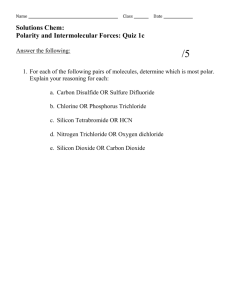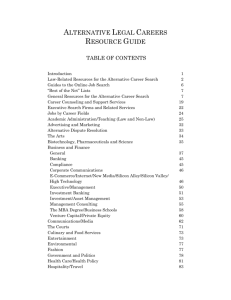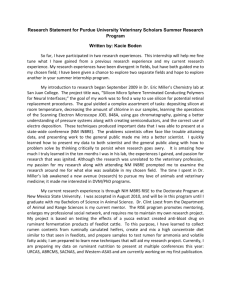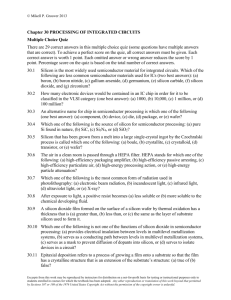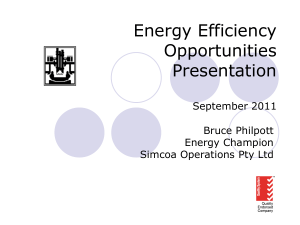Structure, Processing, and Application of Silicon Dioxide
advertisement
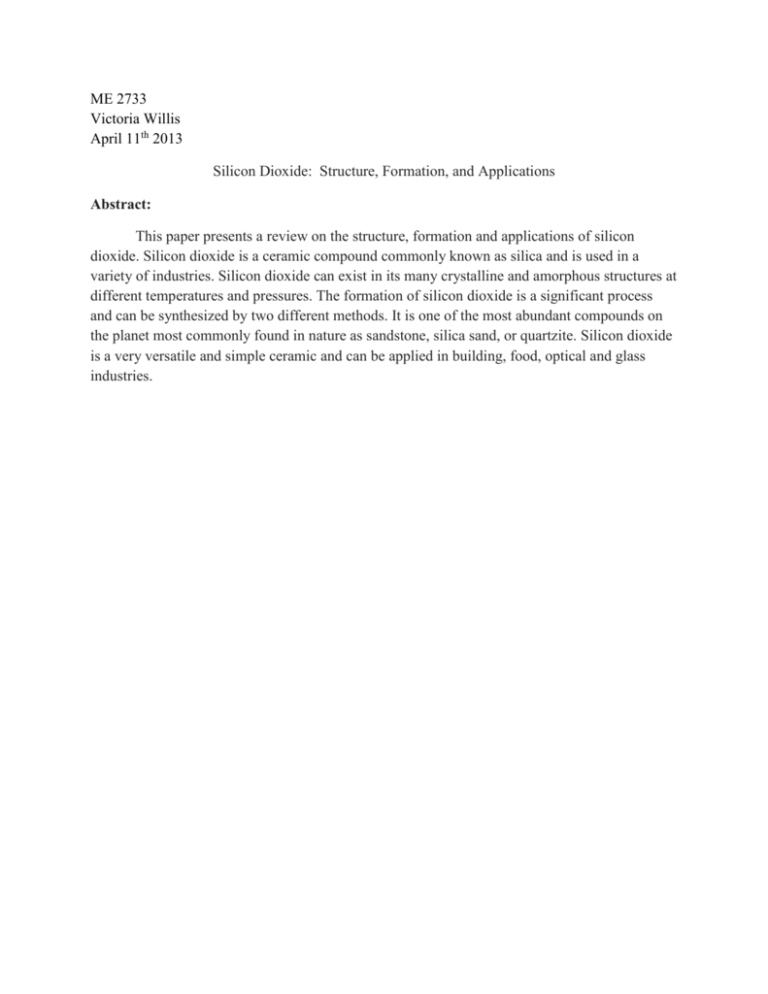
ME 2733 Victoria Willis April 11th 2013 Silicon Dioxide: Structure, Formation, and Applications Abstract: This paper presents a review on the structure, formation and applications of silicon dioxide. Silicon dioxide is a ceramic compound commonly known as silica and is used in a variety of industries. Silicon dioxide can exist in its many crystalline and amorphous structures at different temperatures and pressures. The formation of silicon dioxide is a significant process and can be synthesized by two different methods. It is one of the most abundant compounds on the planet most commonly found in nature as sandstone, silica sand, or quartzite. Silicon dioxide is a very versatile and simple ceramic and can be applied in building, food, optical and glass industries. Introduction: Silicon dioxide is an integral part of a variety of industries due to its simple and neutral properties. Silicon dioxide is considered to be a valuable material in industrial settings due to the production of SiO2 layers by variable processes, including thermal oxidation or chemical vapor deposition. SiO2 can block the diffusion of impurities while acting as an excellent insulator, and is stable at extremely high temperatures, an attractive quality in many materials. Silicon and oxygen are two of the most abundant elements in the earth crust and they consequently compose the bulk of soils, rocks, clays, and sand. Silicon dioxide can exist in multiple polymorphs with varying crystal structures and properties. Structure: Silicon dioxide can exist in multiple structures: quartz (α and β), tridymite (α and β), cristobalite (α and β), stishovite, coesite, and kaetite (synthetic). The α and β describe the low and high of each substance, respectively. Silicon dioxide is electrically neutral and all atoms have stable electronic structures. This allows multiple structures to exist at varying temperatures and pressures. As shown in Figure 1, alterations to temperature and pressure can change the composition and structure of a polymorph. Compositions on the Figure 1 Phase diagram of SiO2 at various line result in 2-3 solid solutions at a specific temperatures and pressures. See reference 1. temperature and pressure. As stated, silicon dioxide can exist in crystalline or amorphous forms. Figure 2 describes the chemical structure of crystalline and non-crystalline forms of SiO2. Each silicon ion is bonded to three oxygen ions in both states. The lattice of the crystalline structure is rigid with fixed bond angles while the noncrystalline structure is much more disordered and irregular. Silicon dioxide has strong covalent bonds, with two oxygen atoms bonded around a central silicon atom. Changes in bridge bonds between the oxygen atoms and the silicon atom result in changes in properties and crystal structure. Non-bridging atoms occur when some oxygen atoms are only bonded to one silicon atom. If the oxygen atoms Figure 2 Chemical structure of crystalline are bridging, the crystalline structure, quartz, will and non-crystalline SiO2. See reference 2. exist. The crystal structures of these polymorphs range from tetragonal, hexagonal, monoclinic, and orthorhombic. Bonds between silicon and oxygen can form a variety of angles without changing the bond energies significantly. This result of flexibility in the bridge bonds causes SiO2 to have different crystalline structures and properties. Formation: In order to form SiO2, oxidation must occur. Two methods to produce SiO2 are by thermal oxidation and chemical vapor deposition. Thermal oxidation is a process to turn silicon into silicon dioxide and is characterized by high temperatures. Figure 3 shows the process of oxidants diffusing across the interface of an already existing oxide. A Figure 3: Process of thermal oxidation reaction takes place at the interface, converting Si to SiO2. of silicon dioxide. See reference 3. Thermal oxidation of silicon is achieved by heating to temperatures ranging from 900-1200⁰C. Pure water vapor or oxygen is typically the atmosphere in which oxidation takes place. Both of these components can diffuse easily through the growing layers at high temperatures. Two approaches to develop silicon dioxide is by dry oxidation and wet oxidation. Dry oxidation describes growth using pure oxygen and is specifically based on the chemical reaction as shown by Reaction 1. 𝑆𝑖 + 𝑂2 → 𝑆𝑖𝑂2 Reaction 1 Wet oxidation describes growth using water vapor and can be shown by Reaction 2. 𝑆𝑖 + 2𝐻2 𝑂 → 𝑆𝑖𝑂2 + 2𝐻2 Reaction 2 Dry oxidation produces a more dense oxide while wet oxidation produces a more open oxide, 𝑔 with a lower density of 2.15 𝑐𝑚3 and weaker structure. Dry oxidation produces SiO2 with a 𝑔 density of 2.25𝑐𝑚3 . Due to stoichiometric relationships in the reaction and the different densities of silicon and silicon dioxide, about 46% of the silicon is consumed during oxidation. In other words, for 1 um of growth, 0.46 um of silicon is consumed. (8) Chemical vapor deposition (CVD) is a chemical process used to produce pure and efficient materials. There are three types of chemical vapor deposition: Atmospheric pressure CVD (APCVD), low pressure CVD (LPCVD), and plasma enhanced CVD (PECVD.) This process is often used in the semiconductor industry to produce thin films. It Figure 4: Overall process of CVD. Reactant gases flow over forms a non-volatile solid film on a substrate substrate, creating a laminar boundary layer and reacting at interface. Byproduct gases are then removed. See reference 5. by reaction of vapor phase chemicals as illustrated by Figure 4. Typically, the substrate is exposed to gases and will react or decompose the substrate surface to produce the desired deposit.[engine hb] Volatile by-products are often formed in the process. Gases are introduced to a reaction chamber in a turbulent and well-mixed stream and the substrate and film-forming chemical reactions occur. The shape of the substrate is extremely important in this process so that the film thickness will be uniform throughout. Desorption and removal of gaseous by-products occurs and the process is continued. Source gases may often include silane (𝑆𝑖𝐻4 ) and oxygen, nitrous oxide (𝑁2 𝑂) and dichlorosilane (𝑆𝑖𝐶𝑙2 𝐻2), and tetraethylorthosilicate (𝑆𝑖(𝑂𝐶2 𝐻5 )4). These reactions are shown by Reactions 3, 4, and 5. 𝑆𝑖𝐻4 + 𝑂2 → 𝑆𝑖𝑂2 + 2𝐻2 Reaction 3 𝑆𝑖𝐶𝑙2 𝐻2 + 2𝑁2 𝑂 → 𝑆𝑖𝑂2 + 2𝑁2 + 2𝐻𝐶𝑙 Reaction 4 𝑆𝑖(𝑂𝐶2 𝐻5 )4 + 6𝑂2 → 𝑆𝑖𝑂2 + 10𝐻2 𝑂 + 8𝐶𝑂2 Reaction 5 Each of the source gases will deposit at various temperatures. Silane deposits between 300-500⁰C, dichlorosilane deposits near 900⁰C, and tetraethylorthosilicate (TEOS) deposits between 650-750⁰C. Reaction 4 occurs by PECVD while Reaction 3 and 5 both take place by APCVD. APCVD operates at atmospheric pressure and results in high deposition rates, however the film is not always uniform. Figure 5 shows the deposition films with APCVD of Reactions 4 and 5. Both have conformal characteristics and the film is in thicker in (a) but is more uniform in (b). LPCVD occurs at a thin boundary layer and reactants easily diffuse into the film. PECVD produces denser films and improve deposition rates. The deposition rate slowly increases with an increasing temperature when at already high temperatures. When this occurs, the reaction rate increases and diffusion decreases. The process of chemical vapor deposition will overall Figure 5 Film depositions on Si using produce a lower quality oxide compared to thermal SiH4 (a) and TEOS (b). See reference . oxidation. There is a higher efficiency in the produced film thickness and usage of reactants CVD is a thermally driven reaction. Applications: Silicon dioxide can be used in a variety of industries involving glass, food, microelectronics, and building manufacturing. Quartz glass provides the basis for manufacturing lenses and other optical components as well as temperature resistant equipment for the chemical industry.[4] Silica is an important material for use as a refractory in the production of glass.[5] The addition of sodium oxide will decrease the softening temperature and the viscosity of SiO2, allowing the glass to be worked at a lower temperatures. In the food and drug industry, amorphous forms of SiO2 are added to salts and spices to prevent caking and act as carriers in drug capsules. They are additionally added to flavoring and colors of foods and are considered safe because they cannot be absorbed by the human body. In microelectronic mechanical systems (MEMS), silicon dioxide is a key material in the production of electronic devices where it acts as a supporting or insulating layer. It is a desirable material to use due to its high thermal stability and abrasiveness. SiO2 acts as an intermetal dielectric where it provides electrical insulation and prevents stress and cracking of other materials. In the building industry, silica consists 19 to 23% of portland cement, a fine powder used for concrete. SiO2 is also found in the compositions of many building materials including plaster, tile and cement. The structure and properties of SiO2 make it an attractive material due to its chemical stability and willingness to react with other compounds. Conclusion: This paper described the structure, formation, and applications of silicon dioxide. Silicon dioxide can exist in a crystalline form or in many amorphous forms in which the bridge bonds between atoms describe the resulting crystal structure. Formation of SiO2 can be completed by thermal oxidation or chemical vapor deposition. Silicon dioxide can be applied to various industries varying from glass, food, microelectronic mechanical systems, and construction. Further research can be constructed for additional properties for silicon dioxide and its crystalline and amorphous structures and their applications in industry. References: 1. “Tectosilicates, Carbonates, Oxides, & Accessory Minerals” available by http://www.tulane.edu/~sanelson/eens211/tectosilictes&others.htm [Accessed 04/09/2013] 2. “Lessons for Cryonics from Metallurgy and Ceramics” available via http://www.benbest.com/cryonics/lessons.html [Accessed 04/07/2013] 3. “Principles of the Oxidation Process” available via http://www.iue.tuwien.ac.at/phd/hollauer/node12.html [Accessed 04/07/2013] 4. “Silicon Dioxide” available via http://www.nanopartikel.info/cms/lang/en/wissensbasis/siliciumdioxid [Accessed 04/07/2013] 5. “Chemical Vapor Deposition- Rice University” available via http://www.precisionfab.net/tutorials02.aspx [Accessed 04/08/2013] 6. “Chemical Vapor Deposition” available via http://www.engineershandbook.com/MfgMethods/cvd.htm [Accessed 04/09/2013]
